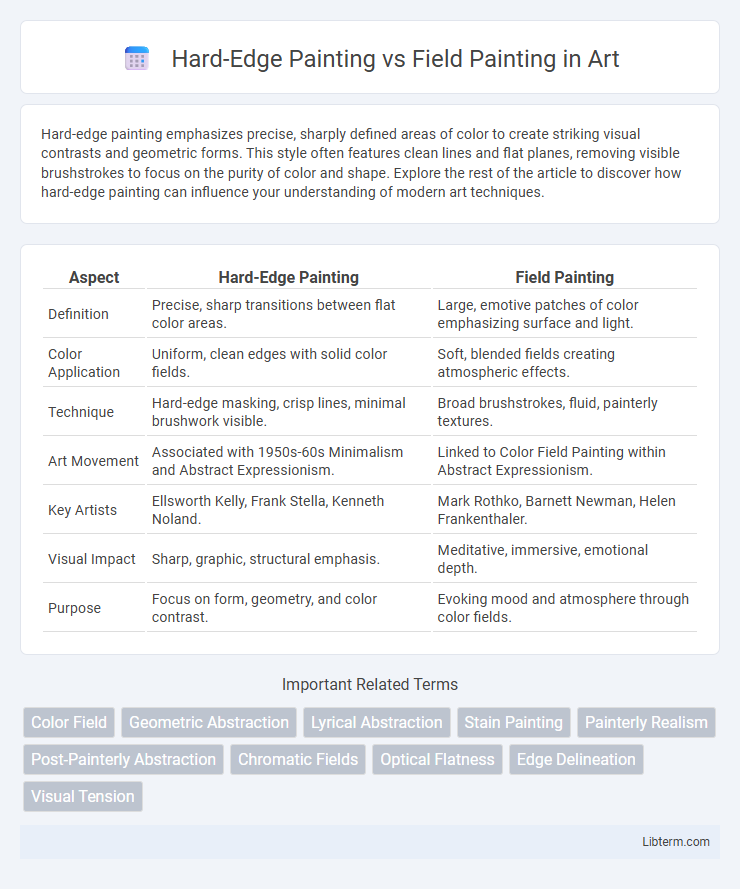Hard-edge painting emphasizes precise, sharply defined areas of color to create striking visual contrasts and geometric forms. This style often features clean lines and flat planes, removing visible brushstrokes to focus on the purity of color and shape. Explore the rest of the article to discover how hard-edge painting can influence your understanding of modern art techniques.
Table of Comparison
| Aspect | Hard-Edge Painting | Field Painting |
|---|---|---|
| Definition | Precise, sharp transitions between flat color areas. | Large, emotive patches of color emphasizing surface and light. |
| Color Application | Uniform, clean edges with solid color fields. | Soft, blended fields creating atmospheric effects. |
| Technique | Hard-edge masking, crisp lines, minimal brushwork visible. | Broad brushstrokes, fluid, painterly textures. |
| Art Movement | Associated with 1950s-60s Minimalism and Abstract Expressionism. | Linked to Color Field Painting within Abstract Expressionism. |
| Key Artists | Ellsworth Kelly, Frank Stella, Kenneth Noland. | Mark Rothko, Barnett Newman, Helen Frankenthaler. |
| Visual Impact | Sharp, graphic, structural emphasis. | Meditative, immersive, emotional depth. |
| Purpose | Focus on form, geometry, and color contrast. | Evoking mood and atmosphere through color fields. |
Introduction to Hard-Edge Painting and Field Painting
Hard-edge painting emphasizes precise, sharp boundaries between areas of color, creating distinct geometric shapes with clean lines that enhance visual clarity. Field painting prioritizes large, uniform blocks of color without defined edges, fostering an immersive experience through expansive color fields that evoke emotional depth. Both styles emerged during the mid-20th century, influencing abstract art by exploring color interaction and spatial perception differently.
Origins and historical background
Hard-edge painting originated in the 1950s and 1960s as a reaction against the gestural brushstrokes of Abstract Expressionism, emphasizing crisp, clean lines and defined areas of color. Field painting emerged earlier, rooted in Color Field painting of the 1940s and 1950s, characterized by large, flat expanses of color meant to evoke emotional resonance through simplicity and scale. Both styles reflect shifts in modern art, with hard-edge focusing on precise geometric form and field painting prioritizing immersive color experience.
Key characteristics of hard-edge painting
Hard-edge painting is characterized by crisp, clean lines and sharply defined geometric shapes, emphasizing precision and clarity without visible brushstrokes. The use of solid, flat areas of color creates a striking contrast, often with contrasting hues placed side by side to enhance visual impact. This style contrasts with field painting's more expansive, softer color zones that blend subtly across the canvas.
Defining features of field painting
Field painting emphasizes broad, flat expanses of color with subtle tonal variations, creating an immersive visual experience. Unlike hard-edge painting, which features sharp, precise boundaries and geometric shapes, field painting often uses soft edges and gradients to evoke depth and atmosphere. The technique prioritizes emotional resonance through color fields rather than distinct forms or lines.
Influential artists in hard-edge painting
Hard-edge painting, characterized by precise, clean lines and geometric shapes, was significantly shaped by influential artists like Ellsworth Kelly, Frank Stella, and Josef Albers, who emphasized clarity and simplicity in form and color. Their works contrast with field painting, which often focuses on large, unified color areas with softer edges, as seen in artists like Mark Rothko and Barnett Newman. Hard-edge painters prioritized sharp delineations and color block interactions, creating a distinct visual language that influenced Minimalism and Color Field movements.
Prominent field painting practitioners
Prominent field painting practitioners like Mark Rothko, Morris Louis, and Helen Frankenthaler emphasized expansive color areas with subtle tonal gradations, creating immersive visual experiences through large, soft-edged fields of color. In contrast, hard-edge painting artists such as Ellsworth Kelly and Frank Stella employed sharply defined, geometric shapes with crisp contours and flat colors for a more structured and precise aesthetic. Field painting's focus on emotional resonance and fluid color transitions marked a distinct movement within abstract expressionism, contrasting with hard-edge painting's clarity and formalism.
Techniques and materials used
Hard-edge painting employs precise, sharply defined shapes with clean lines, typically created using masking tape or stencils to achieve crisp edges. Field painting emphasizes large, flat color areas without clear boundaries, often using brushes or rollers directly on the canvas to produce uniform color fields. Both techniques utilize acrylic or oil paints, but hard-edge painting demands meticulous control of materials to maintain clear separations, while field painting prioritizes expansive, uninterrupted color surfaces.
Artistic intentions and philosophies
Hard-edge painting emphasizes precise, sharply defined areas of color to explore clarity and objectivity in visual perception, rejecting emotional expressiveness. Field painting prioritizes expansive, uniform color fields to evoke immersive and contemplative experiences, focusing on emotional resonance and the infinite nature of color. Both approaches challenge traditional composition but diverge in their philosophical focus on clarity versus emotional depth.
Visual impact and audience perception
Hard-edge painting features sharply defined geometric shapes and clear boundaries that create a striking visual impact by emphasizing precision and contrast, often evoking a sense of order and intentionality in the viewer. Field painting relies on large areas of flat color with less emphasis on distinct shapes, generating an immersive, meditative experience that encourages emotional and sensory engagement. Audience perception of hard-edge works tends to focus on intellectual appreciation of form and structure, while field paintings evoke more intuitive, emotional responses through their expansive color fields.
Legacy and influence in contemporary art
Hard-edge painting, characterized by sharp transitions between color areas, significantly influenced minimalism and geometric abstraction in contemporary art, emphasizing clarity and precision. Field painting, rooted in the Color Field movement, prioritized expansive color planes to evoke emotional depth and spatial ambiguity, shaping abstract expressionism's evolution. Both styles' legacies persist in modern practices that explore color dynamics, spatial perception, and formal simplicity.
Hard-Edge Painting Infographic

 libterm.com
libterm.com